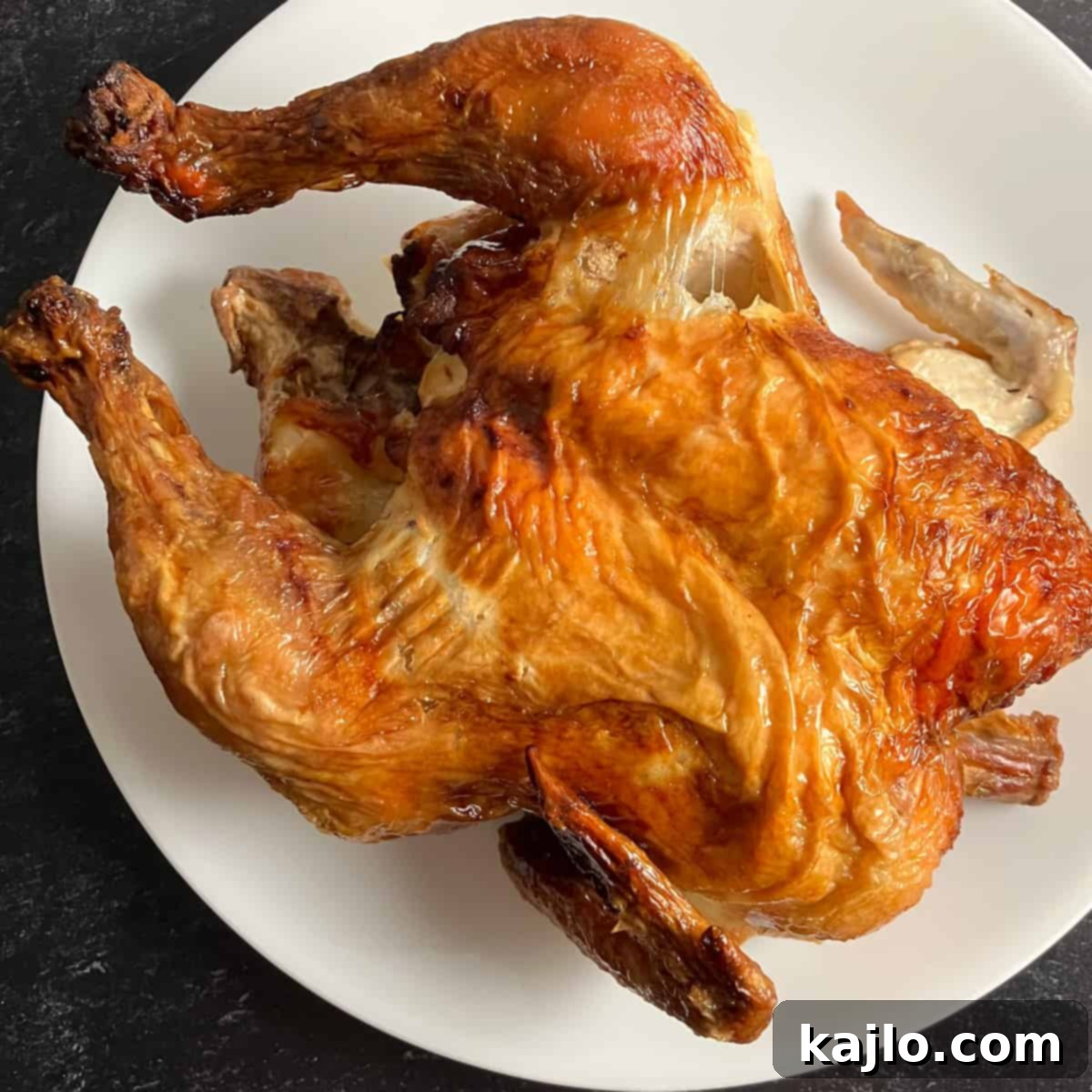How Much is 3 Ounces of Chicken? A Comprehensive Guide to Portion Control, Measurement, and Nutrition
Understanding how much is 3 ounces of chicken is a fundamental step towards effective portion control and a balanced diet. Whether you’re tracking macros, aiming for weight loss, or simply curious about appropriate serving sizes, this guide will demystify the 3 oz chicken portion. Often compared to the size of a deck of playing cards or the palm of your hand, this serving recommendation applies to various cuts like 3 oz chicken breast, chicken thighs, or wings. Here, you’ll learn reliable methods for measuring, discover nutritional insights, and find answers to common questions about chicken portions.
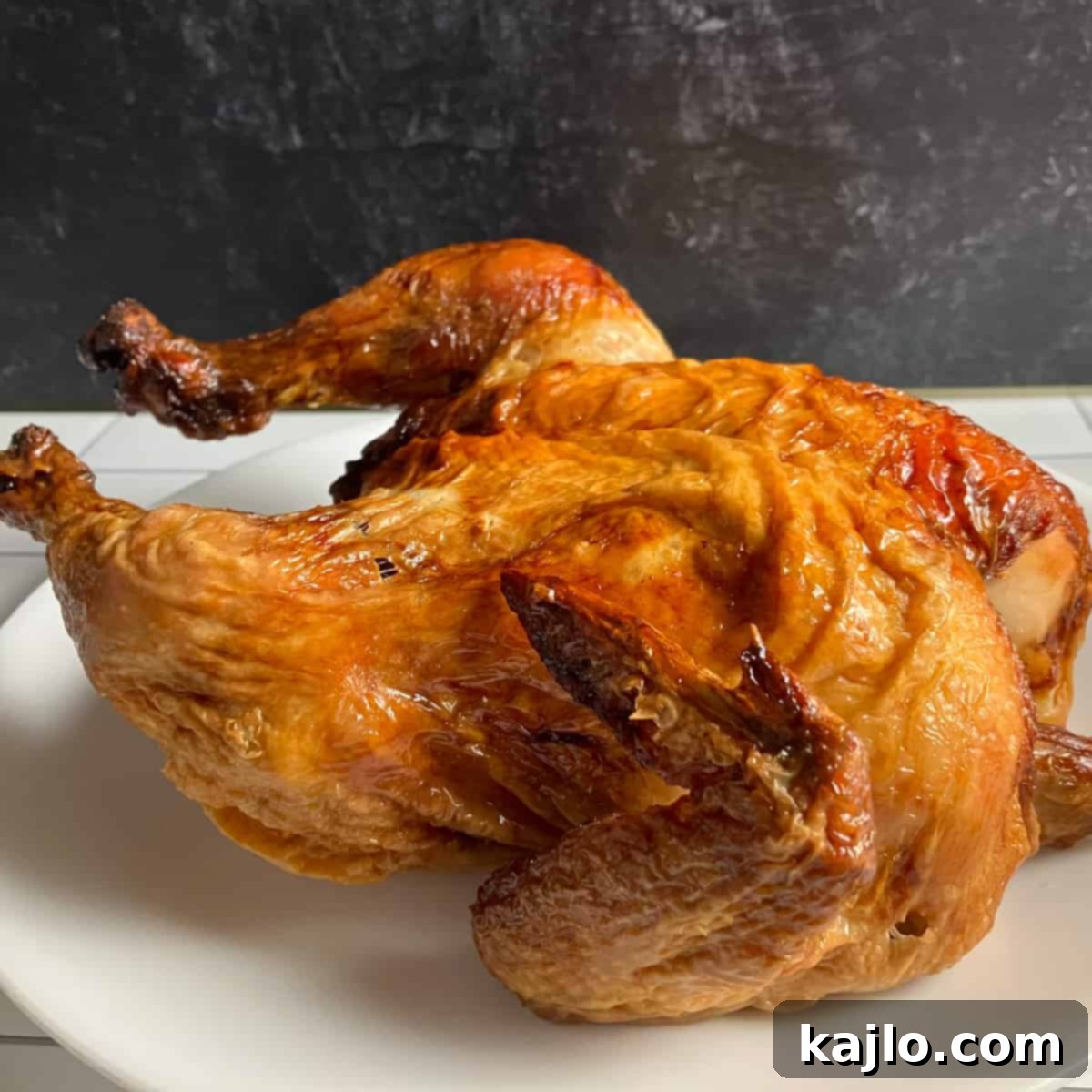
Decoding the 3 Ounce Chicken Serving
The 3-ounce (or 3oz) measurement is frequently cited as a healthy serving size for lean proteins such as skinless chicken breast by various health organizations. This recommendation serves as a general guideline to help individuals manage their protein intake without overconsuming. However, many people are surprised by how big 3 oz of chicken actually is, or rather, how small it can appear.
In the United States, for example, a typical chicken breast can weigh anywhere from 6 to 12 ounces. This means that a single, uncut chicken breast often contains two to four times the recommended 3 oz chicken breast serving. Consequently, you’ll likely need to cut larger pieces of chicken into smaller portions to achieve the suggested 3-ounce size. This initial visual assessment often highlights the common tendency to inadvertently consume larger protein portions than intended.
Is 3 Ounces of Chicken the Right Portion for You?
While the 3-ounce serving is a widely accepted guideline for building a balanced plate, it’s essential to recognize that individual dietary needs can vary significantly. For some, particularly those with specific dietary goals like weight loss, higher energy demands, or adherence to diets such as keto or low-carb, 3 ounces of chicken might not provide sufficient satiety or caloric intake. Individuals practicing intermittent fasting may also require larger servings during their eating windows to meet their daily nutritional requirements within fewer meals.
When you consider how much chicken is 3 oz, reflect on your personal energy levels, activity, and satiety signals. For many, a portion this size might feel insufficient to provide lasting fullness and adequate protein. The Dietary Guidelines for Americans suggests adults consume 5–7 ounce-equivalents of protein per day. However, this is often considered a minimum, and active individuals or those with specific health goals may benefit from higher protein intake. Tailoring your protein intake to your unique needs is key to a sustainable and effective dietary strategy.
Accurate Methods for Measuring 3 Ounces of Chicken
Achieving an accurate 3 ounces of chicken serving is easier than you might think, with several practical methods available. Precision is particularly important for those closely monitoring their nutrient intake.
Kitchen Scale: The Gold Standard for Accuracy
Without a doubt, using a kitchen scale is the most precise method for measuring the weight of chicken. This ensures you get an exact 3-ounce portion every time, eliminating guesswork. It’s crucial to remember the distinction between raw and cooked chicken weight. Approximately 4 ounces (113 grams) of raw chicken will yield about 3 ounces (85 grams) of cooked chicken due to moisture loss during the cooking process. Always weigh your chicken in its raw state if a recipe specifies raw weight, or cooked if it specifies cooked weight, for optimal results.
Visual Comparison: Deck of Playing Cards
For a quick visual estimate when a scale isn’t available, compare your chicken portion to a standard deck of playing cards. A piece of chicken with a similar length, width, and thickness to a deck of cards is roughly equivalent to 3-4 ounces. This is a highly effective visual cue because a deck of cards has a consistent and easily recognizable size. This method is particularly useful for whole pieces like chicken breast or thigh.
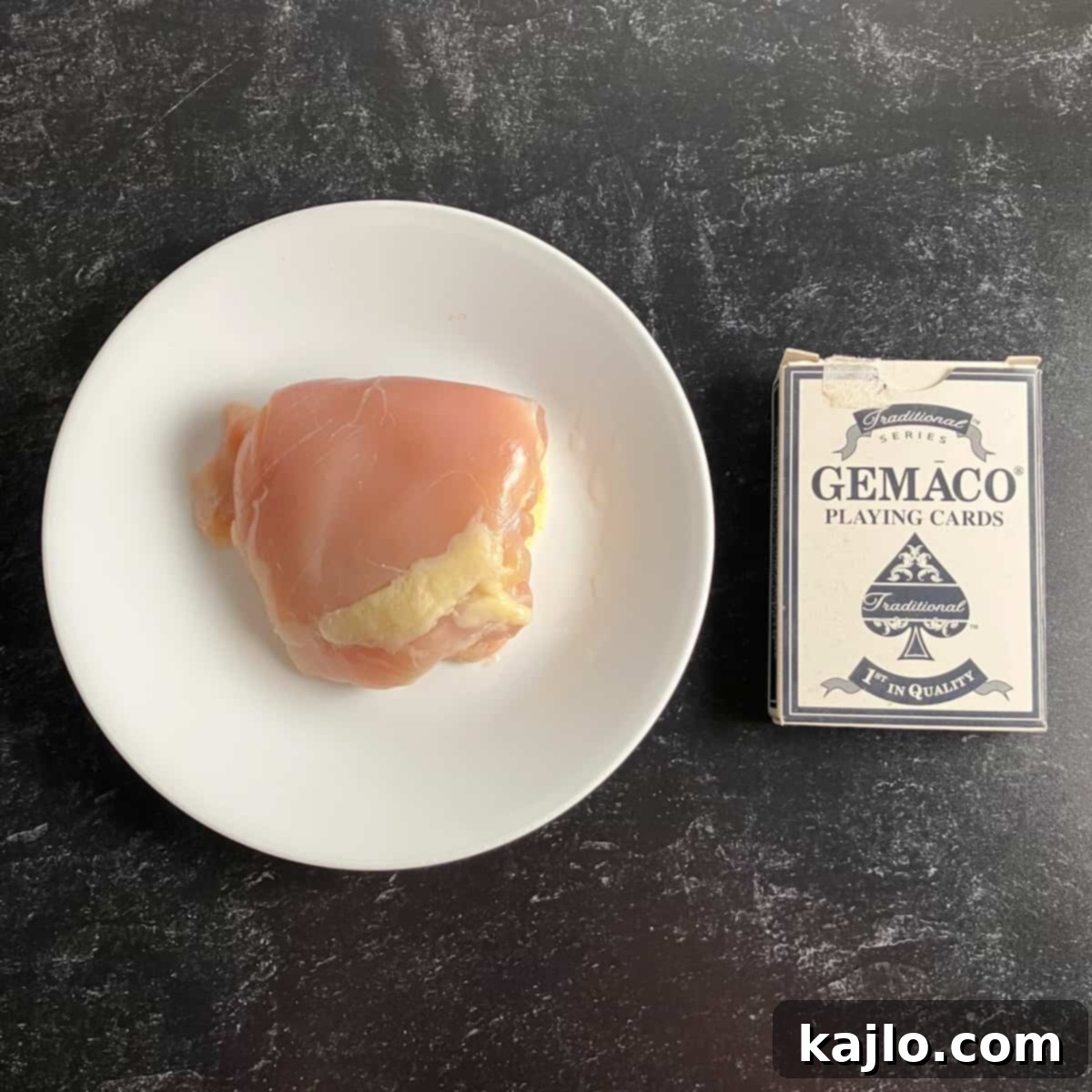
Visual Comparison: The Palm of Your Hand
Another convenient visual estimation technique is to compare the portion of chicken to the palm of your hand. A piece of chicken that is roughly the size of your palm (excluding your fingers) typically measures around 3-4 ounces. While this method is highly convenient, its accuracy can vary depending on individual hand size. It’s a great tool for general estimation when dining out or quickly plating a meal at home, but less precise than a kitchen scale.
Measuring Cups: A Less Accurate Option
Using measuring cups to estimate the weight of chicken is generally the least accurate method. This is because the volume of chicken can fluctuate significantly based on its preparation – whether it’s whole, diced, or shredded. For instance, tightly packed shredded chicken will occupy less volume than loosely chopped chicken of the same weight. While it can provide a very rough estimate (e.g., about ½ to ⅔ cup for 3 ounces), a kitchen scale is always recommended for reliable measurements.
Visualizing 3 Ounces of Chicken: Raw vs. Cooked
Understanding the visual difference between 3 ounces of raw and cooked chicken is vital for accurate portioning. Chicken loses moisture and some fat during cooking, leading to a reduction in weight. This “cooking loss” means that 3 ounces of raw chicken will not be the same as 3 ounces of cooked chicken on your plate.
What does 3 oz of raw chicken look like? Here is a visual comparison of 3 ounces of raw chicken breast versus 3 ounces of raw chicken thigh:
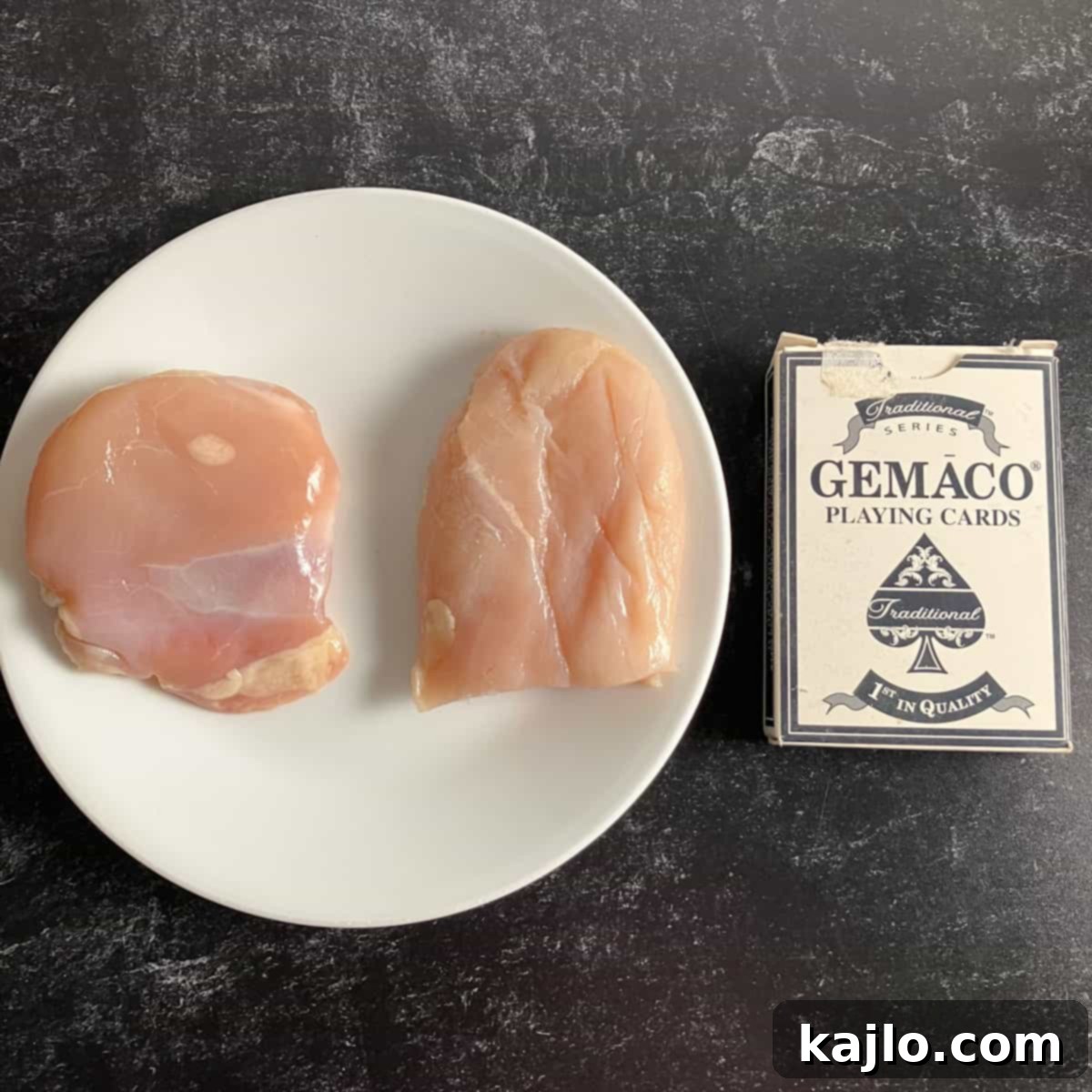
As illustrated, one average boneless, skinless chicken thigh often weighs approximately 3 ounces. A boneless, skinless chicken breast, however, is typically much larger and would need to be cut in half to achieve a 3-ounce portion comparable to the size of a deck of cards.
After cooking, 3 ounces of raw chicken will generally yield a little over 2 ounces of cooked chicken. This shrinkage is important to factor in when preparing meals, especially if you are tracking your protein intake based on cooked weights. For instance, to get a 3-ounce serving of cooked chicken, you would typically need to start with approximately 4 ounces of raw chicken.
Here’s what 3 ounces of chicken looks like when measured after cooking:

Understanding a Single Ounce of Chicken
If you’re curious about even smaller portions, one ounce of chicken is visually equivalent to about three stacked dice or the tip of your thumb. This “rule of thumb” (pun intended!) can be helpful for quick estimates. For exact measurements, particularly for recipes or strict dietary plans, a food scale remains the best tool.
What Does 6 Ounces of Chicken Look Like?
Six ounces of chicken, which is approximately 170 grams, is simply double the visual estimations for 3 ounces. This portion would be roughly equivalent to two standard decks of playing cards or the size of both your palms combined. This larger serving size might be more suitable for individuals with higher protein needs, such as athletes or those following specific dietary regimens.
Converting 3 oz of Chicken to Cups
When it comes to volume, 3 ounces of chicken is approximately ½ to ⅔ cup. It’s important to remember that this is a general guideline. The exact volume can vary significantly based on how finely the chicken is chopped, shredded, or diced. For recipes requiring precise measurements, relying on weight (ounces or grams) is always recommended over volume (cups).
Ounces to Cups Conversion for Chicken Breast
For more specific conversions, particularly for cooked boneless chicken, you can use the following general formula (source):
Approximately 5.25 ounces of cooked boneless chicken equals 1 cup.
This conversion highlights why measuring by weight is often more consistent for protein sources like chicken, as it accounts for density variations that volume measurements might miss.
3 Ounces of Chicken in Grams
For those who prefer metric measurements or are following international recipes, it’s useful to know that three ounces of chicken breast is precisely 85 grams. This weight conversion is universal and applies uniformly across all types of chicken, whether you’re measuring thighs, legs, wings, or any other cut. Using grams can offer a finer level of precision for dietary planning and cooking.
Protein Content in 3 Ounces of Chicken
Chicken is renowned for its high protein content, making it a staple in many healthy diets. The amount of protein in a 3-ounce serving varies depending on the cut and whether the skin is included. Here’s a detailed chart outlining the protein and calorie content for various chicken types in a 3-ounce portion (per Cronometer data):
| Type of Chicken | Protein (g) in 3oz | Calories in 3oz |
|---|---|---|
| Boneless Skinless Chicken Breast (Raw) | 19 | 102 |
| Boneless Skinless Chicken Breast (Cooked)* | 26 | 128 |
| Skin On Chicken Breast (Raw) | 17.7 | 146 |
| Skin On Chicken Breast (Cooked)* | 25.3 | 168 |
| Boneless Skinless Chicken Thigh (Raw) | 16.7 | 103 |
| Boneless Skinless Chicken Thigh (Cooked)* | 21.1 | 152 |
| Skin On Chicken Thigh (Raw) | 14.1 | 188 |
| Skin On Chicken Thigh (Cooked)* | 19.8 | 197 |
| Skinless Chicken Drumstick (Raw) | 16.5 | 99 |
| Skinless Chicken Drumstick (Cooked)* | 20.6 | 132 |
| Skin On Chicken Drumstick (Raw) | 15.4 | 137 |
| Skin On Chicken Drumstick (Cooked)* | 19.9 | 162 |
| Skin On Chicken Wings (Raw) | 14.9 | 162 |
| Skin On Chicken Wings (Cooked)* | 20.2 | 216 |
As the table illustrates, boneless, skinless white breast meat offers the most concentrated protein content per 3 ounces, primarily because it is a leaner protein source. Conversely, chicken thighs and wings, especially with the skin on, contain higher fat content and consequently, slightly less protein by weight. This distinction is important for individuals managing their fat intake or prioritizing lean protein sources.
Calorie Content in 3 Ounces of Chicken
The calorie count for a 3-ounce serving of chicken ranges from approximately 99 to 216 calories. This range primarily reflects plain, unbreaded chicken. Factors that increase the caloric value include breading, frying methods, and leaving the skin on. Dark meat chicken cuts, such as thighs and drumsticks, also tend to be higher in calories compared to white meat.
For those seeking lower-calorie options, skinless chicken breast and skinless drumsticks are excellent choices. On the other end of the spectrum, skin-on chicken wings are typically the highest in calories for a 3-ounce serving. This is largely due to the high skin-to-meat ratio in wings, as chicken skin is rich in fat and thus calories.
3 oz Chicken Breast Nutrition Facts
Beyond protein and calories, chicken breast offers a wealth of essential vitamins and minerals. Here’s a detailed nutrition breakdown for 3 ounces of raw chicken breast, comparing skinless and skin-on options:
| Skinless Chicken Breast | Skin On Chicken Breast | |
|---|---|---|
| Calories | 102 | 146 |
| Total Fat | 2g | 8g |
| Saturated Fat | 0g | 2g |
| Cholesterol | 62mg | 54mg |
| Sodium | 38mg | 54mg |
| Total Carbohydrate | 0g | 0g |
| Fiber | 0g | 0g |
| Total Sugar | 0g | 0g |
| Protein | 19g | 18g |
| Thiamin | 5.3% DV | 3.6% DV |
| Riboflavin | 8.9% DV | 4.3% DV |
| Niacin | 40.8% DV | 42.1% DV |
| Vitamin B5 | 12.7% DV | 6.8% DV |
| Vitamin B6 | 34.5% DV | 22.5% DV |
| Vitamin B12 | 3% DV | 4.8% DV |
| Choline | 12.7% DV | 10.4% DV |
| Folate | 1.9% DV | 0.9% DV |
| Vitamin A | 0.5% DV | 1.4% DV |
| Vitamin C | 0% DV | 0% DV |
| Potassium | 284mg | 187mg |
| Iron | 2% DV | 3.5% DV |
| Calcium | 0% DV | 1% DV |
| Phosphorus | 18% DV | 14.8% DV |
| Zinc | 4% DV | 4.5% DV |
This table clearly shows that chicken breast is an excellent source of B vitamins, particularly Niacin and Vitamin B6, which are crucial for energy metabolism and overall health. It also provides important minerals like phosphorus and potassium. Choosing skinless chicken breast significantly reduces fat and calorie content while maintaining its robust nutritional profile, making it a highly desirable option for health-conscious consumers.
How Many Chicken Strips in 3 Ounces?
The number of chicken strips that constitute 3 oz of chicken strips can vary widely by brand and the size of individual pieces. To ensure accuracy, especially when adhering to dietary plans, weighing your portion on a food scale is highly recommended. Generally, you might expect to get between 1.5 to 5 chicken strips per 3-ounce serving. For example, some brands like Banquet buffalo chicken breast tenders might provide about 5 strips for 3 ounces, while larger Tyson chicken strips could mean only 2 pieces for the same serving size.
How Many Chicken Wings in 3 Ounces?
Typically, 2 to 3 chicken wings are approximately 3 ounces. This number can fluctuate based on the size of the wings. For instance, one larger chicken wing and one small drummette might collectively weigh around 3 ounces.
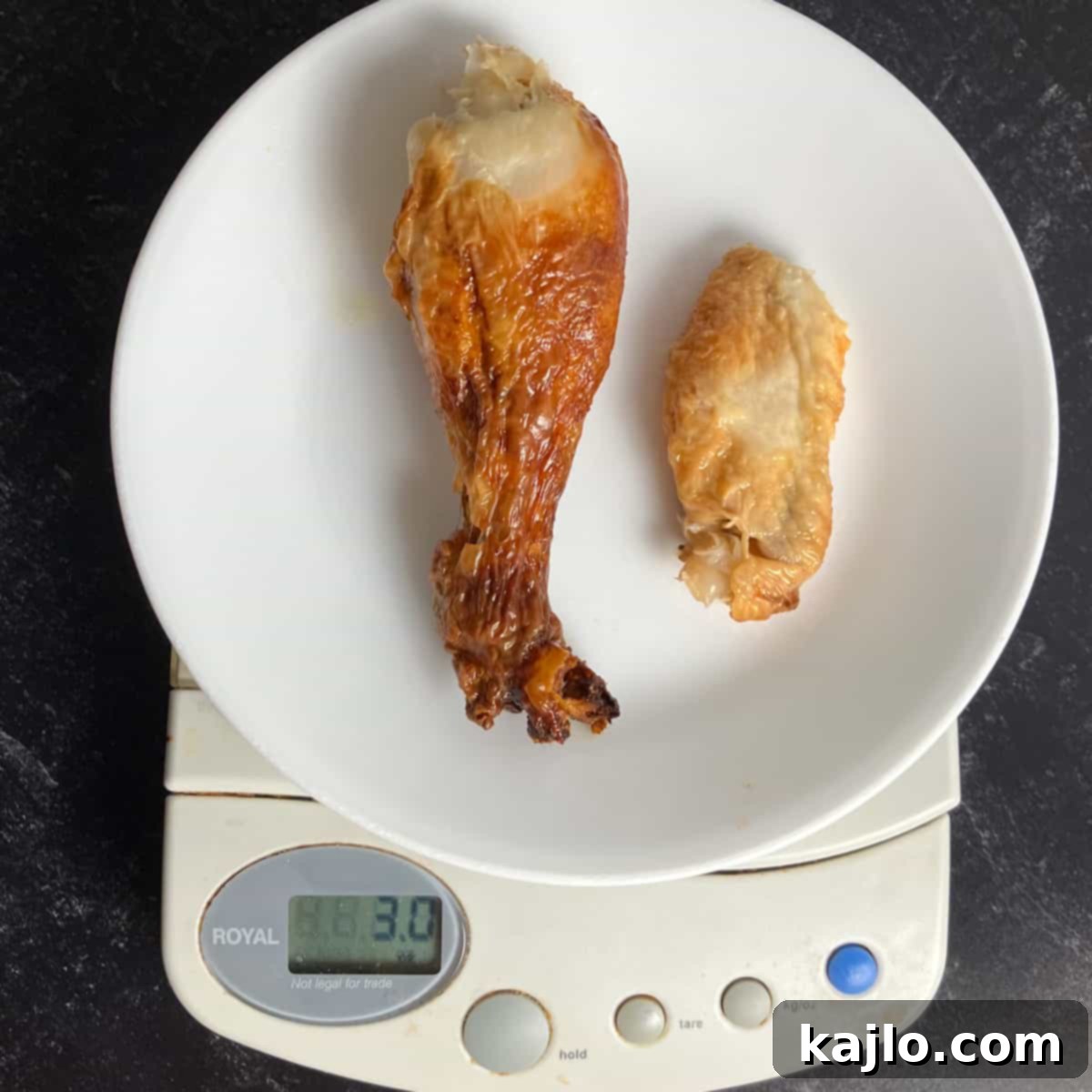
It’s important to note that this is a cooked weight that includes the bones. Once the bones are removed, the actual edible meat and skin from a 3-ounce portion of wings would be closer to 2.2 ounces.
How Much Rotisserie Chicken is 3 Ounces?
Measuring 3 ounces of rotisserie chicken follows the same principles as other chicken types. A serving equivalent to the size of your palm for breast or thigh meat is roughly 3 ounces. If you’re portioning wings or drumsticks from a rotisserie chicken, approximately 2-3 wings or 2 small drumsticks would make up a 3-ounce portion.
How Many Chicken Legs in 3 Ounces?
Chicken leg quarters are often quite large, sometimes weighing up to 8 ounces, and will need to be divided to achieve 3-ounce portions. A single chicken thigh, once deboned and skin removed, typically yields about 3 ounces of cooked meat. Similarly, a large drumstick, after removing the skin and bone, can also provide roughly 3 ounces of meat. Always consider the bone and skin when estimating or measuring, as they contribute significantly to total weight but not to edible meat content.
Should You Eat Chicken Every Day?
While chicken is a highly nutritious and versatile protein, a varied diet is generally recommended for optimal health. It’s best to enjoy a diverse range of protein-rich foods, which can include seafood, eggs, pork, beef, tofu, and various legumes. That being said, if you enjoy the taste, consuming chicken, turkey, or other poultry daily can be a safe and healthy practice. The key is to ensure that your chicken portions don’t displace other essential food groups, such as vegetables, fruits, and whole grains, which provide a broader spectrum of nutrients.
Furthermore, remember that chicken alone does not provide complete nutrition. It’s crucial to complement your chicken intake with other nutrient-dense foods to ensure you’re getting all the necessary vitamins, minerals, and fiber for overall well-being. A balanced approach to protein consumption is vital for long-term health and dietary satisfaction.
Frequently Asked Questions About Chicken Portions
How Many Tyson Chicken Bites is 3 oz?
Approximately 4-5 Tyson chicken bites typically make up three ounces. However, this number can vary depending on the specific size of each individual piece within the product. For the most accurate weight information, especially if you are tracking your diet, it’s always best to use a food scale.
What is 4 oz Chicken?
Four ounces of chicken equals 113 grams. Visually, 4 ounces of chicken is often represented by a portion slightly larger than a standard deck of cards. This is a common serving size in many recipes and for those with higher protein requirements.
How Many Pieces of Popcorn Chicken is 3 Ounces?
For most brands, such as Tyson Anytizers popcorn chicken, you can expect to find about 4-5 pieces of popcorn chicken in a 3-ounce serving. Keep in mind that there can be significant variation based on the size and coating of the individual pieces.
What Does 3 oz of Shredded Chicken Look Like?
Three ounces of shredded chicken is generally a little more than ½ cup in volume. However, as with all volume measurements for chicken, this can vary based on how finely it’s shredded and how densely it’s packed. For precise cooking or dietary needs, weighing the shredded chicken with a food scale is recommended.
What Does 3 oz of Chicken Nuggets Look Like?
On average, a 3-ounce serving of chicken nuggets typically contains 3-5 individual nuggets. The most accurate information will be found on the packaging for the specific brand and product you purchased, as nugget sizes can differ significantly.
Other Helpful Cooking Tips
Beyond portioning chicken, mastering a few other kitchen basics can significantly enhance your cooking and baking success. Here are some useful resources:
- 8 Ounces to Cups Conversion
- Smart Corn Flour Substitute Ideas
- Is All-Purpose Flour the Same as Plain Flour?
- Discover the Best Applesauce Substitute for Baking
How Much Chicken is 3oz (How Big is 3 Ounces of Chicken Breast)
Understanding how much is 3 ounces of chicken is key for portion control. 3oz chicken is approximately the size of a deck of playing cards or the palm of your hand.
Pin Recipe
Ingredients
-
chicken breast OR
-
chicken thigh OR
-
chicken wings OR
-
chicken drumsticks
Love this guide? Please leave a comment below 😊
Instructions
- The most accurate way to measure 3 ounces of chicken (85 grams) is by using a kitchen scale. Remember to weigh approximately 4 ounces (113 grams) of raw chicken if you aim for 3 ounces of cooked chicken due to weight loss during cooking.
- Alternatively, use a visual method: 3 ounces of chicken is roughly the same size as a standard deck of playing cards or the palm of your hand.
- For a rough estimate, 3 ounces of chicken measures between ½-⅔ cup, though this method is less accurate due to variations in how chicken is chopped or packed.
- Once you’ve accurately measured your 3-ounce portion using your preferred method, your chicken is ready to be incorporated into your favorite recipes. Enjoy your perfectly portioned meal!
Equipment
-
Food Scale
Notes
Nutrition Information Disclaimer
All recipes and nutritional information on this website are provided for general guidance. They may not be appropriate for all individuals, depending on specific medical needs or personal preferences. Always consult with a registered dietitian or your physician to determine the most suitable dietary pattern for your health. The nutrition information presented is an estimate provided as a courtesy. It may vary based on specific brands, ingredients, and preparation methods used. Calorie and nutrient data on food labels can sometimes be approximations, so it’s advisable not to overly stress about minor numerical differences. “To taste” in recipes refers to adjusting ingredients according to your personal preference, ensuring you follow food safety guidelines for cooking temperatures. Please do not consume undercooked food.
Nutrition
Shop our cookbook!Easy Air Fryer Recipes for One
Burning your air fryer recipes?Here’s how to fix it!
Join our community! Subscribe for all of the latest and greatest recipes, and follow me on Facebook, Pinterest, Instagram, and YouTube!
